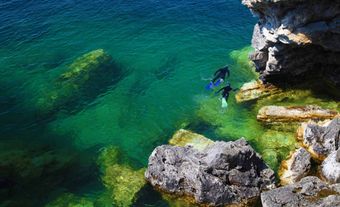Random Island has massive beds of red shale and LIMESTONE on the northwest side, which supported brick factories at Elliott's Cove and Snooks Harbour from the late 1800s. Most of the 11 communities that now ring the island were founded in the mid-1800s by fishermen; 2 communities were founded in the 1970s, Robinson's Bight and Random Heights. Lumbering has been an important industry on the western side of Random Island and today one company remains. Since 1952, the island is connected to insular Newfoundland by the Hefferton Causeway.
-
- MLA 8TH EDITION
- Pitt, Janet E.M.. "Random Island". The Canadian Encyclopedia, 23 January 2014, Historica Canada. www.thecanadianencyclopedia.ca/en/article/random-island. Accessed 23 December 2024.
- Copy
-
- APA 6TH EDITION
- Pitt, J. (2014). Random Island. In The Canadian Encyclopedia. Retrieved from https://www.thecanadianencyclopedia.ca/en/article/random-island
- Copy
-
- CHICAGO 17TH EDITION
- Pitt, Janet E.M.. "Random Island." The Canadian Encyclopedia. Historica Canada. Article published February 07, 2006; Last Edited January 23, 2014.
- Copy
-
- TURABIAN 8TH EDITION
- The Canadian Encyclopedia, s.v. "Random Island," by Janet E.M. Pitt, Accessed December 23, 2024, https://www.thecanadianencyclopedia.ca/en/article/random-island
- Copy
Thank you for your submission
Our team will be reviewing your submission
and get back to you with any further questions.
Thanks for contributing to The Canadian Encyclopedia.
CloseArticle
Random Island
Article by Janet E.M. Pitt
Published Online February 7, 2006
Last Edited January 23, 2014
Random Island, NL, 249 km2 is the second largest island off the Island of Newfoundland (FOGO ISLAND is larger at 254 km2). Random Island runs 40 km east-west and 14 km north-south, and is situated in a deep western indentation of TRINITY BAY.
Random Island, NL, 249 km2 is the second largest island off the Island of Newfoundland (FOGO ISLAND is larger at 254 km2). Random Island runs 40 km east-west and 14 km north-south, and is situated in a deep western indentation of TRINITY BAY. Its name may come from the Old English randon, "disorderly," referring to the sea. The heavily forested island is separated from the mainland by Smith Sound to the north, North West Arm and Random Sound to the southeast. Random Island is dominated by Bakers Loaf, 166 m, on its northeastern tip, and its highest point, Ginpicker Hill at 257 m lies to the southwest.

 Share on Facebook
Share on Facebook Share on X
Share on X Share by Email
Share by Email Share on Google Classroom
Share on Google Classroom

